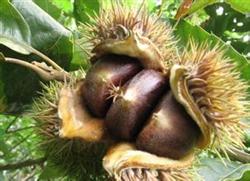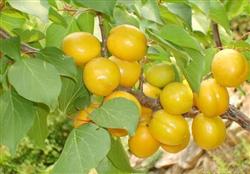Pest Control of Apricot cultivation

Apricot wasp: the larva overwinters in the apricot kernel or in the apricot nucleus on the branch, the female adult lays eggs between the nuclear skin and the almond, the spawning hole on the fruit surface is not obvious, slightly grayish green, sunken, sometimes there is apricot gum outflow from the spawning hole, and the egg period is about 10 days. The hatched larvae eat almonds in the nucleus, resulting in a large number of fruit drops. Mature in about early June, that is, summer and winter in the apricot stone. Control methods: ① picked up the fallen fruit, removed the fruit from the tree, buried it deeply or burned it, and killed the overwintering larvae. ② ploughs the soil deeply (15cm depth is required) and turns the fruit into the soil, so that the adults can not be emerged (the larvae can still emerge normally in the soil layer of 3.5cm). When processing almonds, ③ burned the insect kernels selected by water. ④ was sprayed with 1000-fold solution of 90% crystal trichlorfon at the peak of adult Eclosion in early May. Peach heart borer: the larva harms the fruit. After hatching, the larva bites the pericarp and enters the fruit to feed vertically and horizontally, reaching directly to the core of the fruit. Insect dung is accumulated in the injured fruit, which is bitter and cannot be eaten. Control method: before ① overwintering larvae are unearthed, sprinkle 2000 times of 50% fenitrothion EC in the tree plate, and then turn it deeply. ② remove the diseased fruit and dispose of it at any time. During the concentrated incubation period of ③ larvae, the leaves were sprayed with 2000 times 50% methyl 1605 EC or 1500-2500 times pyrethrin. ④ used peach heart borer sex trap or black light to trap and kill adults. Dendrolimus punctatus: it mainly feeds on buds and new leaves by larvae. When it occurs in large numbers, it can eat up the leaves of the whole tree, affecting flower bud differentiation and fruit setting in the following year. Prevention and treatment: ① combined with winter scissors, cut off the egg block and burn it. When the ② larvae hatched, the leaves of the gregarious larvae were gently plucked and destroyed. ③ foliar spray 50% dichlorvos 1000 times or 40% dimethoate 1000 times to kill leaf-eating larvae. Big green leafhopper: harm to adults and nymphs that suck the sap of leaves. When spawning at the end of autumn, the ovipositor is used to cut the epidermis of the branches of fruit trees, resulting in bruises all over the injured branches and excessive water loss of the trees. Control methods: ① for fruit trees with a large number of overwintering eggs, especially young trees, squeeze the egg nest with wooden sticks to eliminate overwintering eggs. ② should pay attention to remove weeds in the field and reduce the number of intermediate hosts. When ③ adults and nymphs occur, 50% dichlorvos 2000 times or 40% cypermethrin EC 2000 times are sprayed on the leaves. Diamondback moth: damage caused by larvae eating leaves. When young, only eat the mesophyll on the back of the leaves, leaving veins, etc., and then eat the whole leaves when they grow up. Control method: ① is eliminated in the tree plate, especially the overwintering cocoon under the neck of the main root. When ② larvae occur, 50% dichlorvos is sprayed on the leaves. 1000 times of liquid or 2000 times of cypermethrin. Red-necked longicorn beetles: the larvae eat the surface of the branches, which directly affects the growth, and in serious cases, the branches and the whole trees die. Control methods: before the occurrence of adult ①, apply white coating on the trunk or branches (quicklime ∶ sulfur powder ∶ salt ∶ water is 10 ∶ 1 ∶ 0.2 ∶ 40) to prevent adults from spawning. During the occurrence of adult ②, the adult was killed artificially. During the damage period of ③ larvae, the larvae were stabbed to death with iron wire. Apricot bulbous scale: the harm caused by sucking juice on the branches fixed on the branches by female adults or nymphs. Cause the trees to weaken or the branches to die and dry up. Control method: ① scrape off the female before the adult scale shell has been formed and the eggs are not hatched. During the incubation period, ② nymphs were sprayed with 0.2Baomedo stone sulfur mixture or 1500 times of 50% dichlorvos.
- Prev

Chestnut "empty shell" is well controlled
Chestnut "empty shell" is also called "empty canopy", empty shell rate can reach 30%~90%, affecting chestnut yield. The main reasons for producing empty bract of chestnut are: ① poor pollination and fertilization in flowering stage of chestnut. (2) Boron and available phosphorus deficiency in soil. 3. Influence of other factors. One is variety, different variety, male and female inflorescence quantity is different, all...
- Next

Techniques of fertilization and Irrigation Management of Apricot
(1) after the new shoots stopped growing from September to October every year, sufficient basal fertilizer was applied, mainly organic fertilizer such as stable manure and chicken manure, combined with a certain amount of quick-acting fertilizer. the amount of fertilizer should be determined according to the size and growth of the tree, usually 30 kilograms of organic fertilizer per plant, plus about 0.5 kilograms of special compound fertilizer for fruit trees. Cute.
Related
- Moge, come on! The staff of the peasant association in the producing area of cantaloupe were frightened when the crowd gathered.
- Causes and Solutions of low Fruit setting rate of Apple
- Symptoms and control measures of passion fruit virus disease
- Fruit growing lesson: how do apple orchards keep high yields?
- Can you build orchards in the mountains? What are the pros and cons?
- How to manage the coloring period of Crisson grape?
- This paper introduces the processing technology of two kinds of fig products.
- How much is a month for retired teachers in rural areas by 2020?
- How can strawberry planting increase sugar content? We should pay attention to management in many aspects.
- What are the cultivation techniques on how to improve the yield of golden fruit?

